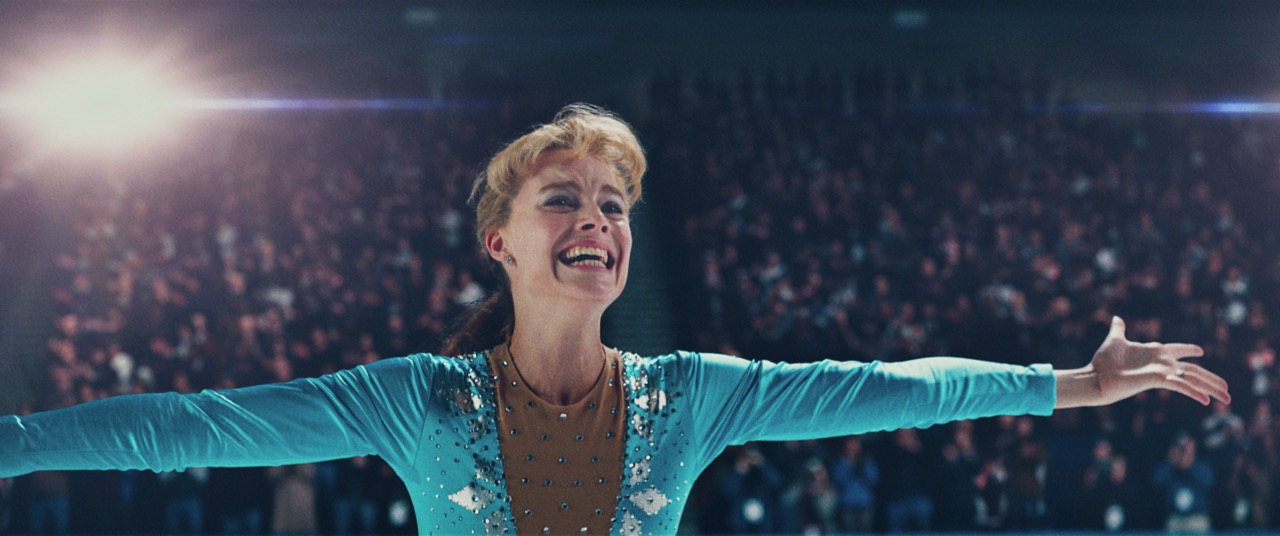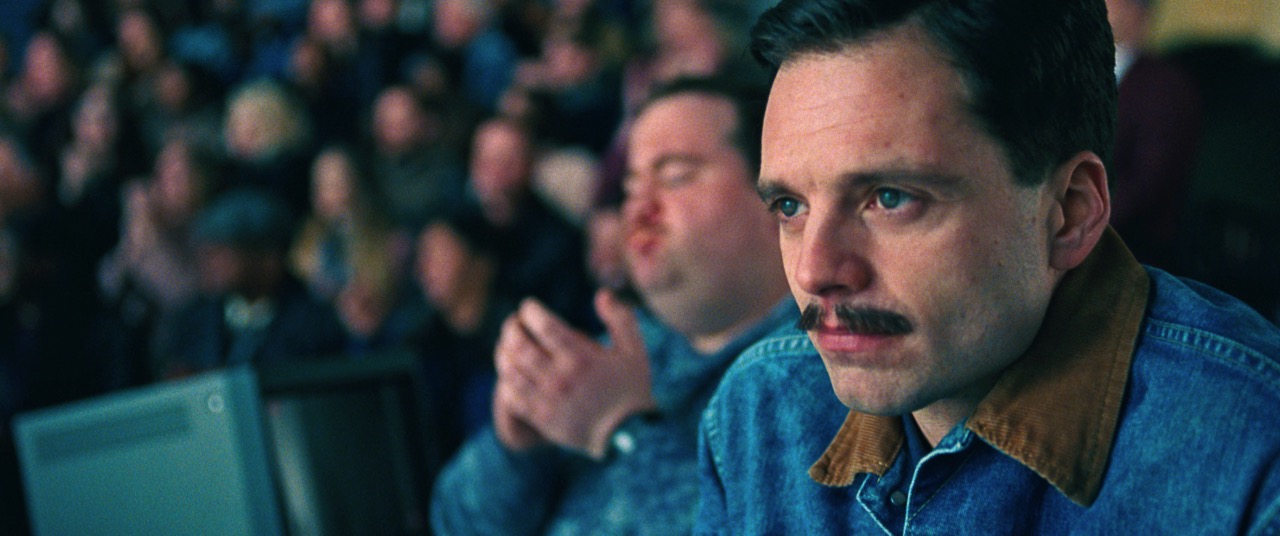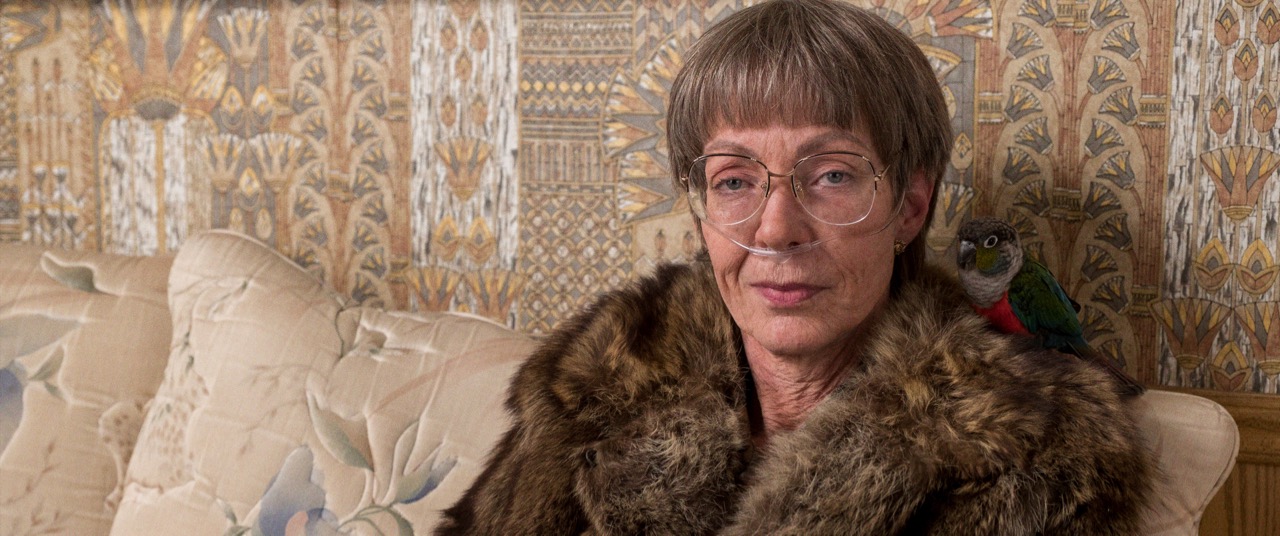 Melissa Anderson
Melissa Anderson
ZZ Top and triple axels: director Craig Gillespie revisits the Tonya Harding saga.

Tonya Harding (Margot Robbie) after landing the triple axel in I, Tonya. Image courtesy NEON.
I, Tonya, directed by Craig Gillespie, opening December 8, 2017,
in New York and Los Angeles
• • •
Characters often stare right into the lens in I, Tonya, a clamorous, dumb recounting of the bleak life and ignominious fall of figure skater Tonya Harding, whose career ended in 1994 after her alleged involvement in an attack on fellow ice athlete Nancy Kerrigan. Repeatedly breaking the fourth wall, the film undams a torrent of redundant dialogue and music choices. Director Craig Gillespie and writer Steven Rogers spell out again and again the movie’s obvious points—about class bias, domestic violence, the rigid policing of femininity in sports, America. An intended black seriocomedy curdles into garish burlesque. The biopic becomes the biohazard.

Jeff Gillooly (Sebastian Stan) watches a routine in I, Tonya. Image courtesy NEON.
The excitable adverbs in the film’s opening text set the desperate, straining tone: “Based on irony free, wildly contradictory, totally true interviews with Tonya Harding and Jeff Gillooly,” the latter the skater’s ex-husband, who would serve jail time for his plotting of the Kerrigan leg-clubbing. This preamble is followed by the actors playing the disgraced pair, Margot Robbie and Sebastian Stan, situated as if in a present-day, sit-down interview, speaking directly to us. The faux-documentary conceit also introduces, among others, LaVona Golden (Allison Janney), Harding’s virago mother, and Diane Rawlinson (Julianne Nicholson), the skater’s genteel coach. Despite the film’s title—which nods to Robert Graves’s I, Claudius, a fictionalized memoir of the Roman emperor—the first-person-singular pronoun often gets lost in Gillespie’s film. With grudges more than two decades old being settled and grievances re-aired by a host of characters, the film sags with conflicting tales. Feebly structured as a Rashomon of the rink, I, Tonya culminates with its protagonist, years removed from both her glory and infamy, declaring this wearying axiom: “There’s no such thing as truth. I mean, it’s bullshit. Everyone has their own truth.”

LaVona Golden (Allison Janney) and her pet bird in I, Tonya. Image courtesy NEON.
There may be no truth, but what are the facts? After that fake-doc opening, the film flashes back to forty years earlier, to flesh out Harding’s biography, to provide some incontrovertible data (all of which is intermittently commented on by the mock-vérité versions of the principal cast). We’re at an ice-skating rink in Portland, Oregon, where LaVona insists that Diane take on wee Tonya (born in 1970) as a pupil. Sucking deeply on a thin brown cigarette and never to be denied, LaVona is an ogress of the Pacific Northwest, her ferocity needlessly underscored by Cliff Richard’s “Devil Woman” blaring on the soundtrack as the formidable mom stares down the courteous trainer. This is but the first example of a chart-topping classic-rock hit deployed to further embellish an already self-evident moment. I, Tonya’s drubbing pleonasm paradoxically reaches its lowest point when dramatizing its heroine’s greatest accomplishment: after Harding becomes, in a 1991 competition, the first American woman to complete a triple axel, the feat (recreated using stunt doubles and digital effects) is scored to Foreigner’s “Feels Like the First Time.”
Yet Harding’s prowess on the ice—her spins and jumps sinuously shot, the camera keeping close, in perhaps the film’s only display of finesse—would seem to be the least important metric. “You’re just not the image we want to portray,” a judge tells her after she confronts him about lower-than-expected scores. Harding has no interest in Beethoven or Gershwin or any other more conventional choice for this high-femme sport: she sets a routine to ZZ Top’s “Sleeping Bag.” Her costumes are always a few shades too brash, the wrong primary color filamented by an even gaudier metallic trim. She smokes, just like her mom. And also just like Ma, she waits tables at greasy spoons, one of the few professions available to a high-school dropout like Harding, whose fourth-place finish at the 1992 Winter Olympics (just behind Kerrigan, played by Caitlin Carver) leaves her with no endorsement deals. She is too hard, too butch, too much—and thus never enough for her sport, so invested in propping up an “old-timey version of what a woman is supposed to be,” in the words of fortysomething Harding.
“I never apologized for growing up poor or being a redneck,” present-day Harding will also say, an affirmation that I, Tonya illustrates with dopey glee: here’s preteen Tonya shooting small game with her dad (LaVona’s fourth husband, soon to split, his exit accompanied by Norman Greenbaum’s “Spirit in the Sky”), their pelts later repurposed as a fur coat. The tatty garment is the skating prodigy’s concession to the fashion and gender-presentation mandates of her sport, to “fitting in,” as Coach Diane advises.

Coach Diane Rawlinson (Julianne Nicholson, left) watches the ice in I, Tonya. Image courtesy NEON.
Like that bunny-hide jacket, I, Tonya also has a raggedy quality, of sloppy attention to detail, evidenced in the clearly fake mustache affixed to Stan (even though that strip of facial hair is singled out, in that introductory faux-doc scene, as one of Gillooly’s most defining traits) and in the unsteady accent and timbre of Australian-born Robbie (who performed credible Brooklynese in her breakthrough film, Martin Scorsese’s The Wolf of Wall Street, from 2013). But again, in depicting the mostly miserable, increasingly violent relationship between Harding and Gillooly, which began when she was in her teens, the film slathers on the superfluous: recoiling from a slap to the face by her boyfriend, Harding looks into the camera and says, “He started hitting me a few months in.”
Via Harding’s direct address, at various stages in her life, audience members will alternately serve as confessors, conspirators, or, in I, Tonya’s most inane attempt at social studies, her assailants. The chiding from 2017 Harding—“I was loved for a minute. Then I was hated. Then I was just a punchline. It was like being abused all over again. Only this time it was by you. All of you. You’re all my attackers too”—arrives after several details of the Kerrigan fiasco have been recapitulated. (Roughly half of the two-hour I, Tonya is devoted to this foolish chapter of mid-’90s scandals.) A toothless gimmick in a film stuffed with them, the condemnation concludes as another ’70s hit (Fleetwood Mac’s “The Chain”) fades out in the background. But the inadvertent earworm of I, Tonya, a work of sonic bombardment, is Kerrigan’s wail after she’s struck: Why? Why? Why?
Melissa Anderson is the film editor of 4Columns. From November 2015 until September 2017, she was the senior film critic for the Village Voice. She is a frequent contributor to Artforum and Bookforum.